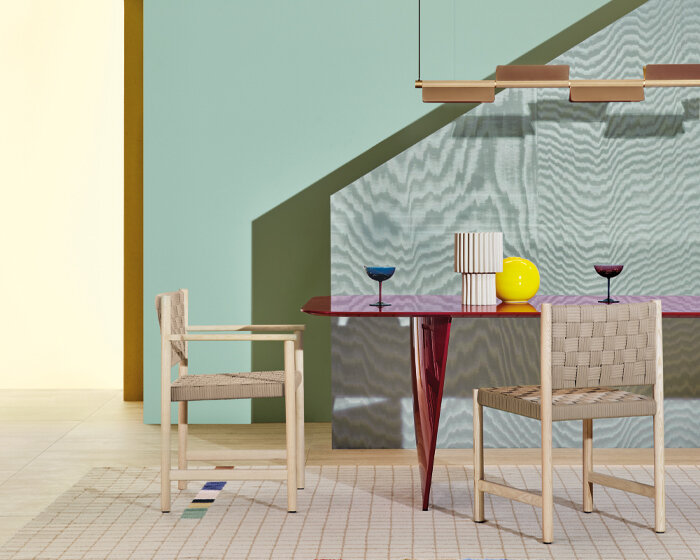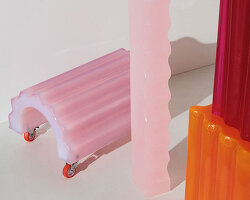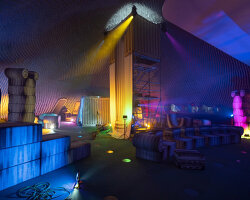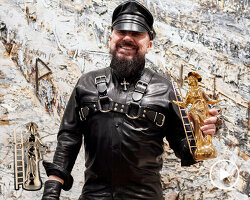the golden madonnina OF THE DESIGN PRIZE 2021 | EXPERIMENTATION
designboom spoke with objects of common interest, the greece and new york-based design studio founded by eleni petaloti and leonidas trampoukis, ahead of being awarded with the golden madonnina trophy 2021 of milan’s THE DESIGN PRIZE (find out more here). operating within the realm of art, design and architecture, objects of common interest creates still life installations and experiential environments and objects. the studio experiments often with materials, textures and hues, like the holographic surface treatment of its ‘future archaeology’ series (see more here), or the opal resin, part of their ongoing exhibition at the noguchi museum, which transforms sunlight into pale blues and deep oranges (more here).
during our interview, leonidas trampoukis talks about the studio’s creative process, their experimentation with different materials and techniques, as well as their new resin fabrication studio, which will open soon close to a newly-formed gallery district in piraeus. ‘we don’t work with a specific material or a specific direction in mind, every project is almost completely new,’ he explains. ‘we’ve worked with many materials like metal, resin, fabrics, a bit of everything, because our intention is not in the form or the material, but it’s in the ideas.’
 tube lights, 2019 | lighting | acrylic
tube lights, 2019 | lighting | acrylic
all images courtesy of objects of common interest
INTERVIEW WITH OBJECTS OF COMMON INTEREST
DB: how was objects of common interest born? what does your practice focus on?
objects of common interest (OoCI): there is no specific date of birth, more or less we run an architectural practice, LOT office for architecture, which we founded earlier on, in about 2015. we started objects of common interest as an experimentation for doing things in smaller scale, not for any particular project, just out of curiosity, and out of the need to do things quicker and faster than architecture. we started doing things just on our own, experimenting and showing it to several people, and they advised us or they said ‘ah this is great stuff, why don’t you do it more professionally or expand it as a business.’ and that’s what we did, we started doing some initial shows in galleries, and reaching out to companies to work with, and then one thing brought the other and it became much more serious. our first approach was when we started working with matter here in new york, which is a gallery-store, and we were making a lot of things in greece and shipping it here to be sold. and then an important thing was when we started working with art athina, doing some lounge and seating installations. and one thing brought the other and it became more serious around 2017, I think, when we won a competition to design a public installation here in new york, at the flatiron plaza. and then throughout all this process, we started blending architecture, space design and objects, and we formalized it as objects upon interest to work in this kind of smaller scale. we are the same people, the same studio, but we have two identities so that we can have freedom to take different directions in our work. objects of common interest installation for art athina
objects of common interest installation for art athina
DB: can you tell me a few things about your process? what is the first step you take when you create a shape or an object?
OoCI: we work together, myself and eleni, and we have a team of seven people in greece and new york. so it is a teamwork, but most of the projects we start out of conversations with eleni basically. even when we have a commission or even when we have certain ideas out of references, we do a lot of things by discussion. we take walks, we discuss, and somehow we define the direction without even sketching many times. and we have a very clear idea of the direction we want to take, and then from that point, each one works on the project with the team or by themselves. we start with sketching after the discussion, and then right away we jump to final production, meaning we don’t really do mock ups, or sometimes we do renderings and 3D models, but we like working with fabricators from the very initial stage, out of experience of the proportions and out of experience of detailing. so we kind of skip this in between process that is time consuming and it’s a lot of trial and error. and in that sense there’s a lot of improvisation but also there’s a lot of trust with the fabricators. more and more, after we’ve been working with them, we know how they work, we know how they think, and also we learn a lot of things from them. so that’s more or less the process, it is very intuitive. we believe in our guts and how we can make something that will come out correct. some projects need more attention, of course, like chairs and more detailed things, and for that we might be doing mock ups. and many times we do a prototype and we present it in exhibitions or in shows, and then we modify it throughout when it passes the prototype stage. standing stones, 2020 | exhibition | adam – brussels design museum
standing stones, 2020 | exhibition | adam – brussels design museum
DB: so instead of having a predefined form in mind, you let a lot of the fabrication influence the way the final product is going to look like? do you sometimes change something while it’s being constructed?
OoCI: exactly, we follow up with the fabricators and then we follow the production and we change things along the way or we let the fabricators also suggest things. we don’t work with a specific material or a specific direction in mind, every project is almost completely new. you’ve seen that we’ve worked with many materials like metal, resin, fabrics, a bit of everything, because our intention is not in the form or the material, but it’s in the ideas. there is an underlying concept, or a common denominator, between all our projects which is simplicity of form, or somehow we incorporate hidden ideas or things that seem like they’re attached but in reality they’re not attached, or the idea of illusion. for example, our tube chair may feel very rigid and solid, but it’s very, very light. it’s made out of sculpted foam, so you can lift it by yourself. or things that we do with inflatables, at the show we have at the brussels design museum, which is standing stones, features elements that are big and large, and they seem like they’re very heavy and solid, but at the same time, they’re made with air, and they’re very light. so these ideas we bring in every project, but every time is completely different with a different material application. so sometimes the material comes first, sometimes the idea comes first, and then we find the material to realize it with. and in that sense, we keep a line of thoughts but every time we allow ourselves think of something new. tube chair, 2018, | chair | foam, fabric
tube chair, 2018, | chair | foam, fabric
DB: do you experiment with materials and treatments yourself in the studio, or do you outsource and visit different craftsmen in their studios?
OoCI: both and in combination. for example, it’s very hard to make the inflatables ourselves, so we work with a specialized fabricator in the UK. we’ve worked with 3D models, and we’ve worked with different mock ups in the studio, and then we sent it directly to them, and they sent us samples and pieces in full scale. then we edit it on the spot and sent back comments and then they sent back the correct version. so working in the actual model, but in real scale mock up. for things like the tube chair, we did the initial prototype ourselves, we got huge chunks of foam and we hand-sculpted it in the studio, and then we gave that to the fabricators. they perfected the technique with machine cutting but still out of the same principles of sculpting, not handmade but machine-made. other times, working with marble for example, we work with 3D models, we do small scale mock ups and then go right away to the marble craftsmen. so it’s it’s really a mix of back and forth collaboration.

volax objects, exhibited at carwan gallery in 2021
OoCI: as I said earlier, sometimes we have a fixation with a material, we say okay, now we want to work with wood because of this and this reason and we stick to the material and then we start to analyze what the properties of the material are, so that it gives us the idea of the form. for example, in the ‘volax’ pieces that we have in carwan gallery (see more here), we wanted to work with wood because we have never worked with wood before and that was the starting point. so, we knew we wanted to make stone formations, we wanted a lighter material, not a heavy one as stone, but at the same time not super light, because it still had to have a presence and boldness. so the idea of wood came out of that, in between something very lightweight and something very heavy, something that can be manageable. and wood can be machined but also handworked, so that allowed us to actually do that process. we did start with a machine process, and then it was hand-finished. so that’s why we worked with wood. at the same time, we wanted to have a very tangible and soft texture, so wood gives that texture. other times let’s say we did things that we wanted to be transparent as a constant, transparent or translucent. so what can be transparent or translucent? it can be glass, it can be acrylic, it can be inflatable. so the selection to be one or the other had to do with weights, with how easy the fabrication is, and how fast we need it. sometimes the logistics gives us the idea to work with a given material. for example, the idea of the inflatables was initially for an exhibition with art athina. they needed something really fast and that needed to materialize within one month, you know greek style, so we had no time to do something more elaborate. we got this connection with a fabricator of inflatables that they could produce in a month. so that’s why we did the inflatables, but also, that brought us an idea to conceptualize the inflatable project, and so on and so on. fabrication process of the ‘volax’ objects
fabrication process of the ‘volax’ objects
DB: besides materiality, you also experiment with forms, like in the inflatables, or even in your functional objects, which often have unexpected forms. where do you draw inspiration for these?
OoCI: it’s a lot about nature and our own personal experiences, travelling or seeing things, inspirational elements. most of our references are not from the design world but from everyday situations. so, for example, the project called ‘formations’ which is these blue settings, was a direct inspiration from new york’s plumbing pipes that we see on the street or in ventilation exhausts. a lot of references as well come from history. lately, we started incorporating more from greek history and archaic elements. the standing stones project was an abstraction of cycladic art figurines, blown up in inflatable scales. and, of course, we do have references from architecture and from design, but we don’t want to be directly referencing something specific. we come from a background of architecture and art, basically, so none of us studied design. we both studied architecture and eleni worked in the art world for many years as an art studio director, so art has been an important reference since the very beginning, specifically abstract art. we’ve seen a lot of inspiration from minimal art and abstract expressionist art. so it’s a blend of experiences, art, less design I would say. I think we look into design more in terms of what has been done and how we can avoid repeating something that has been done in trying to be more original, but also not to copy elements that have been around. formations | installation at art athina
formations | installation at art athina
DB: during milan design week this year, you presented the ‘future archaeology’ objects, which were made of steel, right? but they had this holographic treatment on them.
OoCI: they were made of steel and wood. so, it’s a combination basically for logistics again. some things could not be made in metal, some things could not be bent in wood. we didn’t really care about the idea of being wood or metal, but we cared about the idea of being simplistic in form. the initiation for that project was the finish, not the material itself.

future archaeology at alcova during milan design week 2021
OoCI: in a whole different set of work, we were interested in color, color changing and perception. an earlier project was ‘relativity of color’, these glass and acrylic elements that were inspired by josef albers’s studies on color. this one was about color as well, color and illusion. this paint, this kind of finish is very illusionary, it changes as you move around the object, it changes if you put it in a dark setting or in a light setting. that was the whole idea about it. and it came about with prior experiments with the resin casting, and this opalescent material that we have developed with a fabricator. we’ve actually acquired his business. it is a special pigment that we put in the blend and it refracts color and creates different shades and color hues, so we want to do that with a paint. relativity of color, 2017 | glassware | hand-blown glass, acrylic
relativity of color, 2017 | glassware | hand-blown glass, acrylic
DB: is it the same pigment you’ve used for some of the objects in the noguchi museum exhibition?
OoCI: it is the same, it’s what we call ‘opal’, which is mimicking the natural opalescent gemstone that exists in nature, but in acrylic. up until now, it only exists in blown glass – glass opalescent – but not in solid volume. we are the only ones who can make the acrylic opal right now, exactly because of the experiments with this fabricator who we acquired the business from. it’s basically like a solid piece that we pour colors and special secrets in and create layers of material that has this iridescent effect. offerings-rock II, 2000 | part of objects of common interest’s exhibition at the noguchi museum
offerings-rock II, 2000 | part of objects of common interest’s exhibition at the noguchi museum
image © designboom
DB: can this also be used in different forms, or in bigger forms?
OoCI: yes, it can, and that’s what we’re going to be experimenting with in our own fabrication studio. it can be anything we want it to be, we control what color, how transparent, how translucent, and what size we want it to have. we create moulds, and we cast it in. we can also create very rectangular pieces out of it, just casting blocks and cutting them. so we will be making a lot of things out of that as well, soon.

doric columns at the noguchi museum
OoCI: we will start a fabrication studio focused in casting resin. resin is a mix of chemicals, which produce this very hard mixture that is not heavy, and not light, it’s in between the weight of wood and marble. we acquired this machinery from a fabricator we used to work with in new york after he closed his 40-year business, and right now, as we speak, we have filled two shipping containers that are on their way from new york to athens. we have a space in piraeus, close to a newly-formed gallery district where carwan gallery is. it’s an 800 sqm (8000 sqft) space that will be very raw, and where we will be doing casting of resin. initially we will start with our own experimentations, and then we will open it up after we perfect the techniques to making things for others as well, for designers, for art pieces, for all kinds of things about resin. opal bent stool, 2019 | stool | acrylic
opal bent stool, 2019 | stool | acrylic
DB: what else are you working on at the moment?
OoCI: we have a commission from rimowa, the company with high end suitcases. they have a show in paris and they invited a few designers to use their signature material, the aluminum-patterned surface, to do a unique piece, and we designed a totem. then we are planning a museum show next year in hamburg, curated by maria cristina didero, but I cannot say more about it yet. we have many architectural projects in parallel. we have been doing a townhouse here in brooklyn, williamsburg, new york, we’re doing a couple of private houses in greece, and we’re doing a cafe for an argentinian coffee brand that is moving to open a new business in new york, we’re doing their headquarters in greenpoint. we are also doing a re-branding and design of the clothing showrooms of nili lotan, a fashion brand from the 90s. we’re doing a store for them in palm beach, florida. over there we’re doing the design of the space but it will be also kind of a gallery space, and we’re putting a lot of our own objects as well, some of the pieces from carwan gallery will go there. so it will be a store but almost designed like a gallery space. doric columns, 2020 | kinetic object | kvadrat exhibition
doric columns, 2020 | kinetic object | kvadrat exhibition
DB: do you often use your own objects in your architecture projects?
OoCI: not really, almost never. this might be almost the first time that we will have a space designed full with our own pieces ,and also custom-designed pieces there. it is not our intention, we keep architecture and objects completely separate, but if people want to blend them we are fine with that as well. objects of common interest sketches of doric columns
objects of common interest sketches of doric columns
THE DESIGN PRIZE is an annual award program that celebrates excellence on a global scale. initiated in 2017 and curated by designboom, with patronage by the city of milan, THE DESIGN PRIZE recognizes both the extraordinary achievements and little sparks of beauty and delight that have emerged over the past 12 months.
happening now! yusuke kawai explains how his design for pedrali’s kawara lighting collection fuses sacred japanese architecture with industrial precision.



















